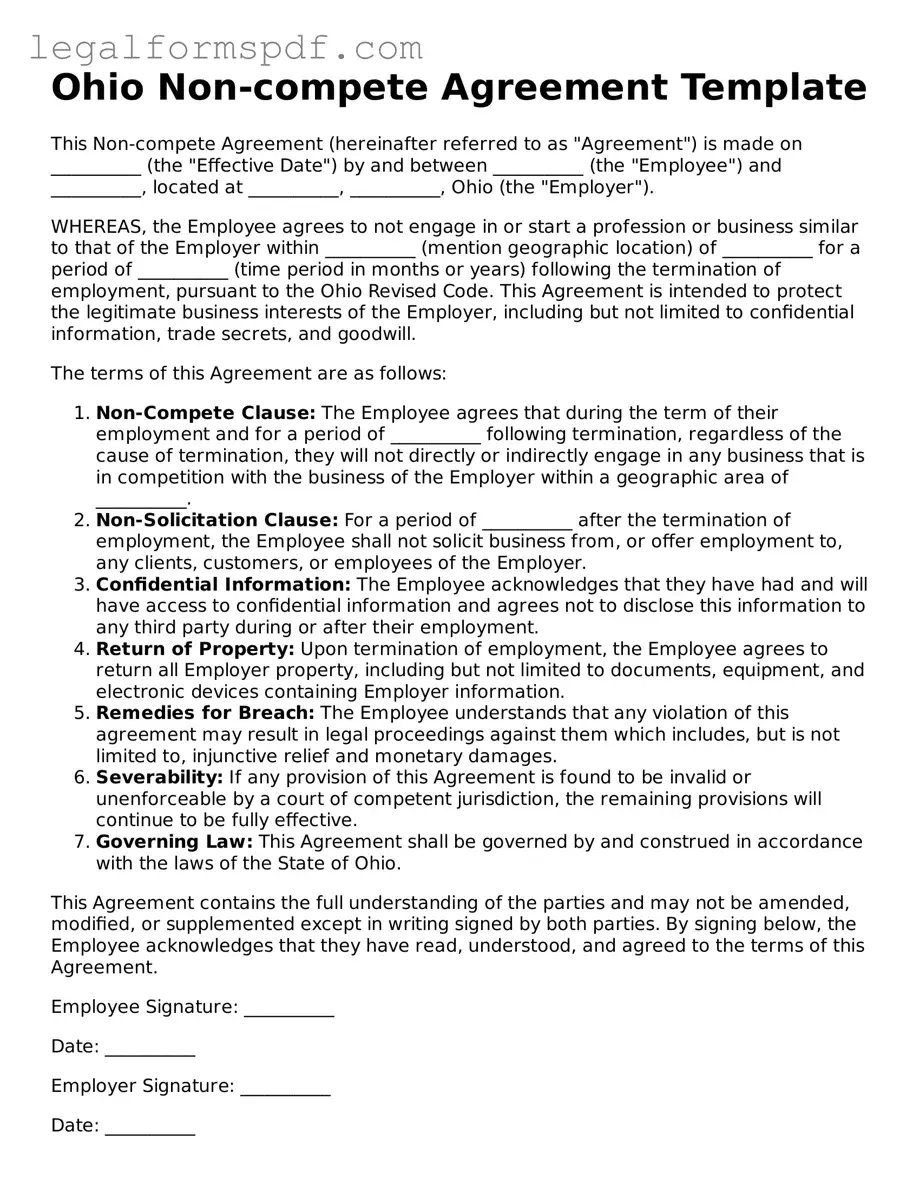The Ohio Non-Compete Agreement form is similar to a Confidentiality Agreement in that both documents protect sensitive information. While the Non-Compete Agreement restricts former employees from working in similar businesses or industries, a Confidentiality Agreement prevents the sharing of confidential corporate information. Both agreements are essential for safeguarding a business’s proprietary information and competitive edge.
Similar to an Employment Agreement, the Ohio Non-Compete Agreement form outlines specific terms between an employer and an employee. However, while the Employment Agreement covers a broad range of employment terms such as duties, salary, and termination, the Non-Compete focuses specifically on restricting the employee's ability to enter into competition with the employer post-employment, emphasizing the limitations on the employee’s future employment opportunities.
A Non-Disclosure Agreement (NDA) shares similarities with the Ohio Non-Compete Agreement in its aim to protect company information. However, the NDA is expressly focused on the non-sharing of confidential material, knowledge, or information. In contrast, the Non-Compete Agreement restricts competitive employment actions but both are used to protect the company's interests.
The Ohio Non-Compete Agreement form and the Non-Solicitation Agreement both limit an employee's actions post-employment, but they target different behaviors. While the Non-Compete restricts working in competing businesses, the Non-Solicitation Agreement prevents the former employee from soliciting the employer's clients or employees. Each plays a unique role in protecting a business’s interests from potential competitive threats.
Similar in nature to an Employee Handbook, the Ohio Non-Compete Agreement form lays down specific rules to be followed. However, the Employee Handbook is broader, covering various aspects of employment policies, procedures, and expectations, while the Non-Compete Agreement narrowly focuses on prohibiting competitive employment activities.
Intellectual Property (IP) Assignment Agreements are akin to the Ohio Non-Compete Agreement form in that they both involve protection measures for the company. An IP Assignment Agreement requires employees to assign any creations that may be considered intellectual property to the employer, whereas the Non-Compete Agreement restricts employees from using knowledge or information gained during employment in future competitive ventures.
A Contractor Agreement shares similarities with the Ohio Non-Compete Agreement because both define terms of a working relationship. However, the Contractor Agreement is between a company and a self-employed individual or service provider, emphasizing the scope of work, payment, and duration, while the Non-Compete Agreement specifically addresses restrictions on the contractor or employee’s engagement in competitive practices post-contract or employment.
The Ohio Non-Compete Agreement form and Severance Agreement can be related in the context of an employee's departure from a company. A Severance Agreement outlines the pay and benefits an employee receives upon leaving, possibly including a non-compete clause. Although they serve different primary purposes—the Severance Agreement is about compensation and the Non-Compete about restricting future employment—the inclusion of non-compete terms in a Severance Agreement links them.
Business Purchase Agreements are somewhat similar to the Ohio Non-Compete Agreement, as both can contain clauses to prevent competition. In a Business Purchase Agreement, the seller can be restricted from starting a new, similar business that competes with the one sold. This stipulation protects the buyer’s investment in the same way that a Non-Compete Agreement protects an employer's business interests by limiting former employees’ ability to compete directly with the business.
Lastly, an Independent Contractor Non-Compete Agreement is closely related to the Ohio Non-Compete Agreement, targeting individuals who are not traditional employees. Like the employee-focused Non-Compete Agreement, this version applies to consultants and freelancers, outlining restrictions on their ability to engage in business that competes with the client they serve. Both documents aim to protect the business interests of the entity that hires the services, either an employee or an independent contractor.
